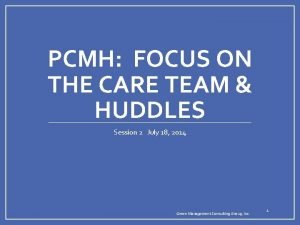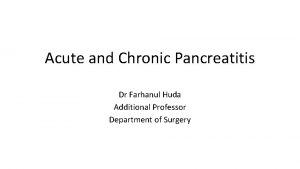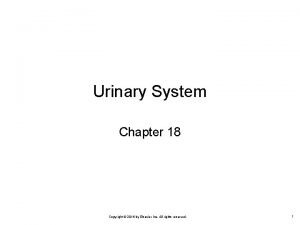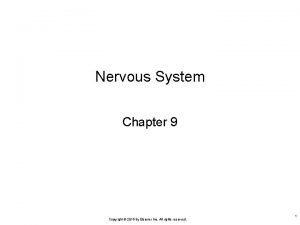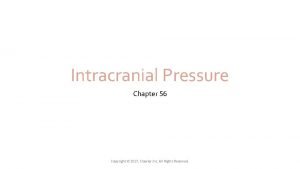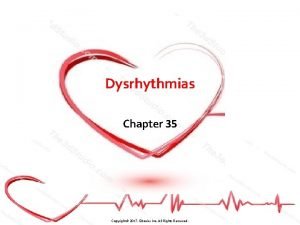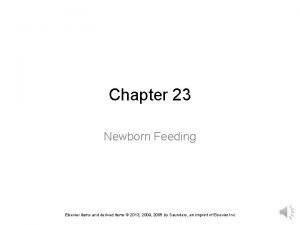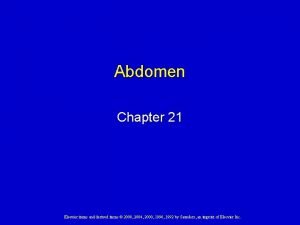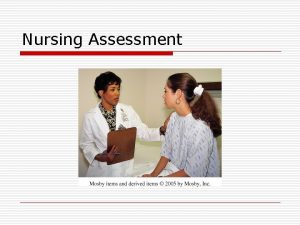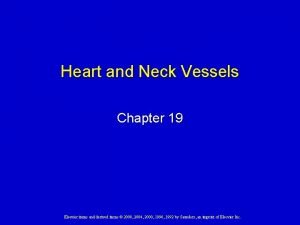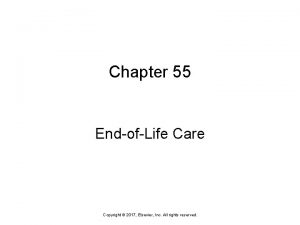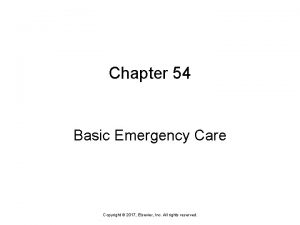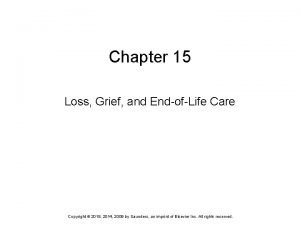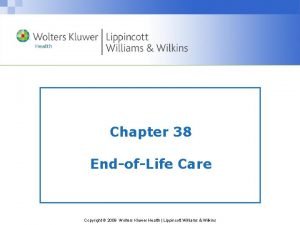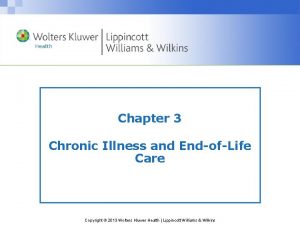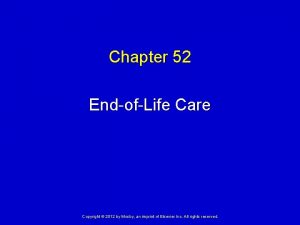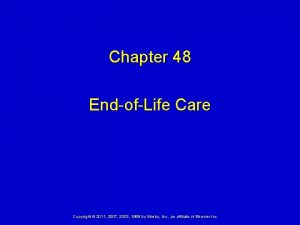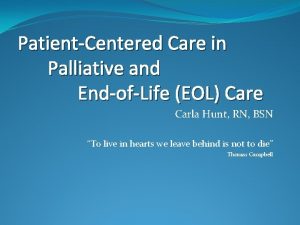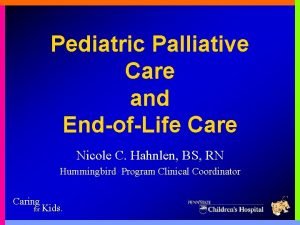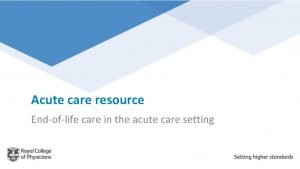EndofLife Care Chapter 55 z Copyright 2017 Elsevier























- Slides: 23

End-of-Life Care Chapter 55 z Copyright © 2017, Elsevier, Inc. All rights reserved.

2 z End-of-Life Care § End-of-life care describes the support and care given during the time surrounding death. § Death may be sudden or expected. § Some people gradually fail. § End-of-life care may involve days, weeks, or months. Copyright © 2017, Elsevier, Inc. All rights reserved. § According to the National Institute on Aging, most people die in hospitals or nursing centers. § Hospice care is becoming a common option. § You must understand the dying process. § Then you can approach the dying person with caring, kindness, and respect.

3 z Terminal Illness § Terminal illness is an illness or injury from which the person will not likely recover. § Many illnesses and diseases have no cure. § The body cannot function after some injuries. § Recovery is not expected. § The disease or injury ends in death. Copyright © 2017, Elsevier, Inc. All rights reserved. § Doctors cannot predict the time of death. § Hope and the will to live strongly influence living and dying.

4 z Terminal Illness (Cont. ) § Persons with terminal illnesses can choose palliative care or hospice care. § Palliative care—focuses on relief of symptoms. The illness is also treated. § Care is for a long-term illness that will cause death. § Settings include hospitals, nursing centers, and the person’s Copyright © 2017, Elsevier, Inc. All rights reserved. home. § Hospice care—focuses on the physical, emotional, social, and spiritual needs of dying persons and their families. Hospice care is not concerned with cure or life-saving measures. § Often, the person has less than 6 months to live. § Hospitals, nursing centers, and home care agencies offer hospice care, or a hospice may be a separate agency.

5 z Attitudes About Death (Cont. ) § Spiritual needs relate to the human spirit and to religion and religious beliefs. § Attitudes about death are closely related to religion. § Some believe in an afterlife; others do not. § There also are religious beliefs about the body’s form after Copyright © 2017, Elsevier, Inc. All rights reserved. death. § Some believe the body keeps its physical form § Others believe only the spirit or soul is present in the afterlife. § Reincarnation is the belief that the spirit or soul is reborn in another human body or in another form of life.

6 z Attitudes About Death (Cont. ) § Age § Adults fear: § Pain and suffering § Dying alone § The invasion of privacy Copyright © 2017, Elsevier, Inc. All rights reserved. § Loneliness and separation from loved ones § Adults worry about the care and support of those left behind. § Adults often resent death because it affects plans, hopes, dreams, and ambitions.

7 z The Stages of Dying § Dr. Elisabeth Kübler-Ross described five stages of dying. § Stage 1: Denial § § Stage 2: Anger § § Copyright © 2017, Elsevier, Inc. All rights reserved. The person thinks, “Yes, me” and is very sad. Stage 5: Acceptance § § The person now says, “Yes, me, but. . . ” Stage 4: Depression § § The person thinks “Why me? ” Stage 3: Bargaining § § “No, not me” is a common response. The person is calm and at peace. Dying persons do not always pass through all five stages. Some move back and forth between stages.

8 z Comfort Needs § Comfort involves physical, mental and emotional, and spiritual needs. § Comfort goals are to: § Prevent or relieve suffering to the extent possible § Respect and follow end-of-life wishes Copyright © 2017, Elsevier, Inc. All rights reserved. § You need to listen and use touch. § Some people may want to see a spiritual leader. § Some want to take part in religious practices. § Provide privacy during prayer and spiritual moments. § Be courteous to the spiritual leader. § Handle religious objects with care and respect.

9 z Comfort Needs (Cont. ) § Physical needs § Dying may take a few minutes, hours, days, or weeks. § To the extent possible, independence is allowed. Copyright © 2017, Elsevier, Inc. All rights reserved. § As the person weakens, basic needs are met. § Every effort is made to promote physical and psychological comfort. § The person is allowed to die in peace and with dignity.

10 z Comfort Needs (Cont. ) § Pain § Some dying person do not have pain. Others may have severe pain. § Pain management is important. § The following promote comfort: § Good skin care Copyright © 2017, Elsevier, Inc. All rights reserved. § Personal and oral hygiene § Back massages § Good alignment § Frequent position changes § Supportive devices

11 z Comfort Needs (Cont. ) § Breathing problems § Shortness of breath and difficulty breathing (dyspnea) are common end-of-life problems. § Semi-Fowler’s position and oxygen are helpful. Copyright © 2017, Elsevier, Inc. All rights reserved. § Noisy breathing—called the death rattle—is common as death nears. § This is due to mucus collecting in the airway. These may help: the side-lying position; suctioning by the nurse; and drugs to reduce the amount of mucus.

12 z Comfort Needs (Cont. ) § Vision, hearing, and speech § Vision blurs and gradually fails. § Secretions may collect in the eye corners. § Good eye care is needed. § Hearing is one of the last functions lost. Copyright © 2017, Elsevier, Inc. All rights reserved. § Always assume that the person can hear. § Speech becomes harder. § It may be hard to understand the person. § Sometimes, the person cannot speak.

13 z Comfort Needs (Cont. ) § Mouth, nose, and skin § Oral hygiene promotes comfort. § Oral hygiene is needed if mucus collects in the mouth and the person cannot swallow. § Crusting and irritation of the nostrils can occur. § Nasal secretions, an oxygen canula, and a naso Copyright © 2017, Elsevier, Inc. All rights reserved. -gastric tube are common causes. § Circulation fails and body temperature rises as death nears. § The skin is cool, pale, and mottled (blotchy). § Perspiration increases. § Skin care, bathing, and preventing pressure ulcers are necessary.

14 z Comfort Needs (Cont. ) § Nutrition § Nausea, vomiting, and loss of appetite are common at the end of life. § As death nears, loss of appetite is common. § The person may choose not to eat or drink. Copyright © 2017, Elsevier, Inc. All rights reserved. § Elimination § Urinary and fecal incontinence may occur. § Constipation and urinary retention are common. § Enemas and catheters may be needed.

15 z Comfort Needs (Cont. ) § The person’s room: § Provide a comfortable and pleasant room. § Remove unnecessary equipment. Copyright © 2017, Elsevier, Inc. All rights reserved. § The person and family arrange the room as they wish. § This helps meet love, belonging, and esteem needs. § The room should reflect the person’s choices.

16 z Comfort Needs (Cont. ) § Mental and emotional needs are very personal. § Some persons are anxious or depressed. § Others have specific fears and concerns. Examples include: Copyright © 2017, Elsevier, Inc. All rights reserved. § Severe pain § When and how death will occur § What will happen to loved ones § Dying alone

17 z The Family § This is a hard time for the family. § Show you care by being available, courteous, and considerate. § Family members usually can stay as long as they Copyright © 2017, Elsevier, Inc. All rights reserved. wish. § Respect the right to privacy. § However, do not neglect care because the family is present. § The family goes through stages like the dying person. § They need support, understanding, courtesy, and respect. § A spiritual leader may provide comfort.

18 z Legal Issues § Consent is needed for any treatment. § When able, the person makes care decisions. § Some people make end-of-life wishes known. Copyright © 2017, Elsevier, Inc. All rights reserved. § The Patient Self-Determination Act and OBRA give persons the right to: § Accept or refuse treatment § Make advance directives § An advance directive is a document stating a person’s wishes about health care when that person cannot make his or her own decisions.

19 z Legal Issues (Cont. ) § A living will is a document about measures that support or maintain life when death is likely. § A living will may instruct doctors: § Not to start measures that prolong dying § To remove measures that prolong dying § Durable power of attorney for health care gives the power to Copyright © 2017, Elsevier, Inc. All rights reserved. make health care decisions to another person (Health Care Proxy). § After consulting with the person and family, doctors often write “Do Not Resuscitate” (DNR) or “No Code” orders for terminally ill persons. § This means that the person will not be resuscitated.

20 z Signs of Death § In the weeks before death, the following may occur: § Restlessness and agitation § Shortness of breath § Depression § Anxiety § Drowsiness § Confusion Copyright © 2017, Elsevier, Inc. All rights reserved. § Constipation or incontinence § Nausea § Loss of appetite § Healing problems § Swelling in the hands, feet, or other body areas § Pauses in breathing

21 z Signs of Death (Cont. ) § As death nears, the following signs may occur fast or slowly: § Movement, muscle tone, and sensation are lost. § Peristalsis and other gastrointestinal functions slow down. § Body temperature rises. § Circulation fails. Copyright © 2017, Elsevier, Inc. All rights reserved. § The respiratory system fails. § Pain decreases as the person loses consciousness. § The signs of death include no pulse, no respirations, and no blood pressure. § The pupils are fixed and dilated. § A doctor determines that death has occurred.

22 z Care of the Body After Death § Care of the body after death is called post-mortem care. § A nurse gives post-mortem care. Copyright © 2017, Elsevier, Inc. All rights reserved. § You may be asked to assist. § Post-mortem care begins when the doctor pronounces the person dead. § Post-mortem care is done to maintain a good appearance of the body.

23 z Care of the Body After Death (Cont. ) § The right to privacy and the right to be treated with dignity and respect apply after death. § Within 2 to 4 hours after death, rigor mortis (the stiffness or rigidity of skeletal muscles that occurs after death) develops. § The body is positioned in normal alignment before rigor Copyright © 2017, Elsevier, Inc. All rights reserved. mortis sets in. § When an autopsy is done, post-mortem care is not done. § An autopsy is the examination of the body after death. § Follow agency procedures for an autopsy.
 Copyright secondary sara (2017) answers
Copyright secondary sara (2017) answers Tertiary level of care
Tertiary level of care Pcmh huddle template
Pcmh huddle template Jessie qian
Jessie qian Reed elsevier ventures
Reed elsevier ventures Ieee elsevier
Ieee elsevier Elsevier clinical key
Elsevier clinical key Elsevier 2005
Elsevier 2005 Elsevier 2005
Elsevier 2005 Descending limb of nephron loop
Descending limb of nephron loop General sense
General sense Elsevier
Elsevier Copyright
Copyright Ees elsevier
Ees elsevier Hs and ts
Hs and ts Picture for newborn
Picture for newborn Elsevier
Elsevier Elsevier
Elsevier Elsevier
Elsevier Elsevier
Elsevier Reaxys elsevier
Reaxys elsevier Elsevier
Elsevier Elsevier
Elsevier Precordium
Precordium


